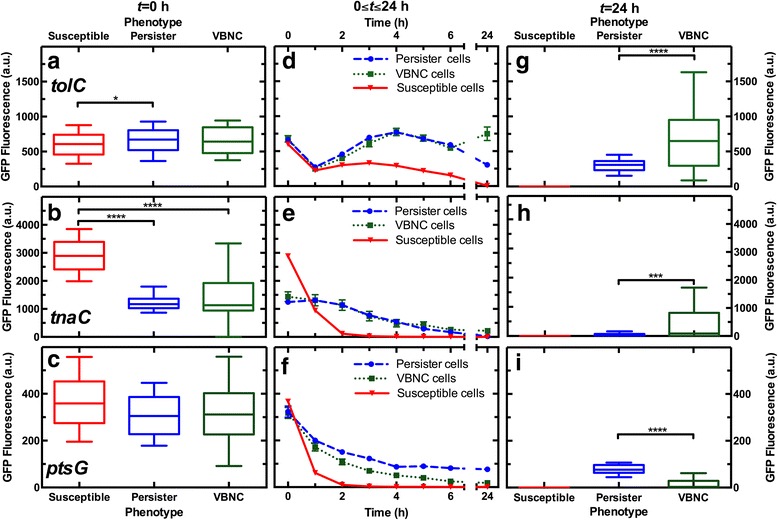Fig. 4.

Distribution of GFP fluorescence levels in viable but non-culturable (VBNC) cells before and after drug treatment. Distribution of fluorescence levels in VBNC (green) cells, alongside the susceptible (red) and persister (blue) phenotypes in the (a) tolC, (b) tnaC, and (c) ptsG reporter strains before drug treatment (t = 0). Susceptible cells include both susceptible lysed and susceptible non-lysed phenotypes since these exhibit similar GFP fluorescence patterns. d–f Corresponding average pattern of fluorescence levels for the different phenotypes and reporter strains throughout the microfluidic assay, 0 < t < 24 h. g–i Distributions of fluorescence levels after drug removal and 21 h exposure to LB. The bottom and top of the box are the first and third quartiles, the band inside the box is the median, the bottom and top whiskers represent the 10th and 90th percentiles, respectively. Data are obtained at least in biological triplicate (N = 3) for each reporter strain employed for a total of n S = 6659, n P = 198, and n VBNC = 147 fluorescence patterns of single susceptible, persister, and VBNC cells, respectively. We did not observe any significant difference between the results obtained from different biological replica. Due to the large sample sizes, error bars are small compared to the corresponding mean values and are hidden behind some of the data points in (d), (e) and (f). The differential tnaC fluorescence levels in VBNC cells with respect to susceptible cells allows identifying the former as the dimmest cells before drug treatment, establishing tnaC-GFP as a potential biomarker to isolate VBNC cells, alongside persister cells, within the untreated clonal population. Moreover, at t = 24 h, VBNC cells display increased fluorescence levels in the tolC and tnaC reporter strains, whereas persister cells show increased fluorescence levels in the ptsG reporter strain. Therefore, the three investigated reporter strains could be used in future as biomarkers to distinguish and isolate VBNC from persister cells after drug challenge and exposure to LB, these two phenotypes often being confused
